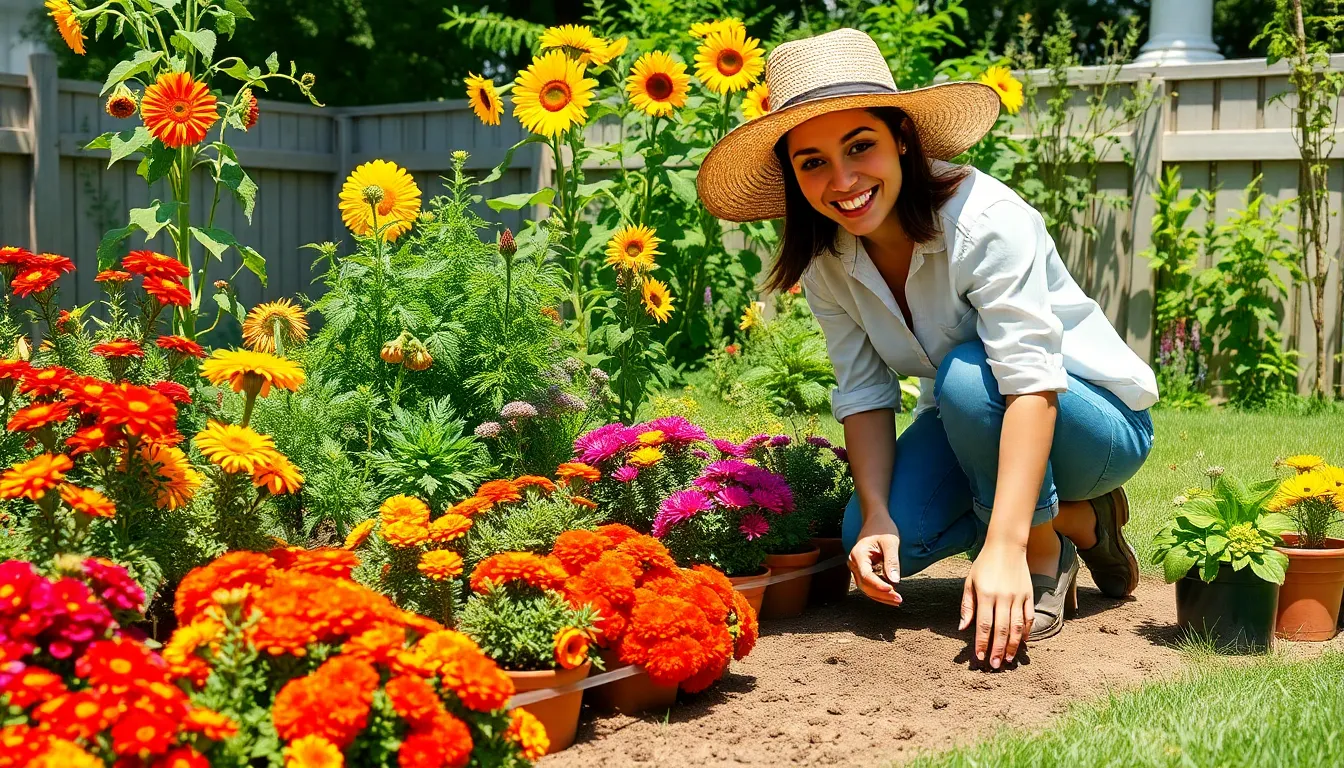Stepping into the world of gardening can feel a bit like diving into the deep end without a life jacket. But fear not, aspiring green thumbs! With a few simple tips, anyone can transform their backyard into a flourishing oasis rather than a wild jungle of chaos. Whether you’re aiming for a bountiful vegetable patch or a colorful flower bed, the journey begins with some essential know-how.
First Time Gardening Tips
Starting a garden involves making informed choices. Below are crucial considerations for beginners.
Choosing the Right Location
Selecting the right location sets the foundation for garden success. Aim for a site with well-draining soil and access to water. Avoid areas with heavy foot traffic or competing plants. Consider proximity to the house for convenience. Parking lot or dense tree canopies hinder growth and light penetration. Assess nearby structures that create shade, limiting sunlight exposure. Check local zoning laws as some regulations might influence garden placement. This thoughtful planning improves overall results.
Understanding Sunlight Requirements
Recognizing sunlight requirements shapes plant selection. Most flowers and vegetables thrive in 6 to 8 hours of direct sunlight daily. Assess the garden space throughout the day to spot sunny versus shaded areas. Some plants prefer partial shade or full sun, affecting growth patterns. Morning sunlight is best as it dries moisture, reducing disease risk. Tools like a light meter can measure sunlight intensity. This knowledge leads to better outcomes and healthier plants.
Selecting Your Plants

Selecting the right plants plays a crucial role in successful gardening. Beginners should consider plant types that suit their skill level and local climate.
Beginner-Friendly Plants
She recommends starting with easy-to-grow options. Herbs like basil and cilantro thrive with minimal care. Vegetables such as lettuce and radishes grow quickly, making them ideal for beginners. Flowers like marigolds and sunflowers add vibrant color and attract beneficial insects. These plants typically require less maintenance and adapt well to different soil types.
Seasonal Planting Guide
Understanding the right seasons for planting enhances growth potential. Spring usually symbolizes the best time to plant most vegetables and annual flowers. Cool-season crops like spinach and peas thrive in early spring. In contrast, summer is perfect for warm-season plants like tomatoes and peppers. Fall often provides a second chance for some crops, such as kale and carrots, which can withstand light frost. Consulting local planting calendars helps ensure optimal planting times. By adhering to seasonal guidelines, gardeners increase their chances of success.
Preparing Your Garden Soil
Preparing garden soil is crucial for success. Quality soil supports healthy plant growth, so testing and enhancing its fertility is essential.
Testing Soil Quality
Testing soil quality involves checking its pH level and nutrient content. A pH level between 6.0 and 7.5 suits most plants. Soil test kits can be purchased from garden centers or online. They typically include instructions for collecting samples. It’s recommended to sample multiple spots in the garden to get an accurate reading. Labs also offer professional soil testing services for a more detailed analysis. Nutrient levels, particularly nitrogen, phosphorus, and potassium, significantly impact plant health. Understanding soil quality helps gardeners make informed amendments.
Enhancing Soil Fertility
Enhancing soil fertility involves adding organic matter and essential nutrients. Compost enriches the soil and improves its structure, allowing for better drainage and aeration. Well-rotted manure offers a nutrient boost, supporting vigorous plant growth. Additionally, cover crops can be planted in the off-season to improve soil health. These crops add organic material when tilled back into the soil. Mulching helps retain moisture and suppress weeds, further supporting soil fertility. Regularly testing soil and making necessary adjustments promotes a thriving garden environment.
Watering Best Practices
Watering techniques significantly impact garden health. Observe plants closely to determine their specific watering needs. Most vegetables and flowers thrive with consistent moisture, but overwatering can lead to root rot. Water deeply to encourage strong root development instead of frequent shallow watering.
Morning is the best time to water gardens. This practice ensures plants absorb moisture before the heat of the day causes rapid evaporation. If watering in the afternoon, do it early enough to allow leaves to dry before evening, reducing the risk of fungal diseases.
Using a drip irrigation system or soaker hoses promotes efficient water usage. These methods deliver moisture directly to the roots, minimizing evaporation and fungal issues caused by wet foliage. Regularly check hoses for blockages, as clear pathways receive water better.
Rain gauges help monitor weekly precipitation. Understanding rainfall can prevent overwatering, conserving water and saving time. Adjust watering schedules based on weather patterns and annual rainfall averages in the area.
Mulching also aids in moisture retention. Use organic materials like straw or wood chips to minimize evaporation and keep soil temperatures moderate. A layer of mulch reduces weed competition, further improving the growing environment for plants.
Finally, seasonal changes influence watering practices. During hot summer months, increase watering frequency as plants demand more water. In cooler seasons, reduce watering based on soil moisture and plant growth rates. Keeping track of these factors ensures a thriving garden throughout the year.
Conclusion
Starting a garden can be an exciting adventure filled with learning and growth. By following the essential tips outlined, first-time gardeners can lay a strong foundation for their gardening journey. From selecting the right location and plants to understanding soil preparation and watering techniques, each step plays a vital role in cultivating a thriving garden.
With patience and perseverance, aspiring gardeners will see their efforts blossom into beautiful and productive spaces. Embracing the process and enjoying the small victories will make the experience even more rewarding. It’s time to dig in and watch the garden flourish.

